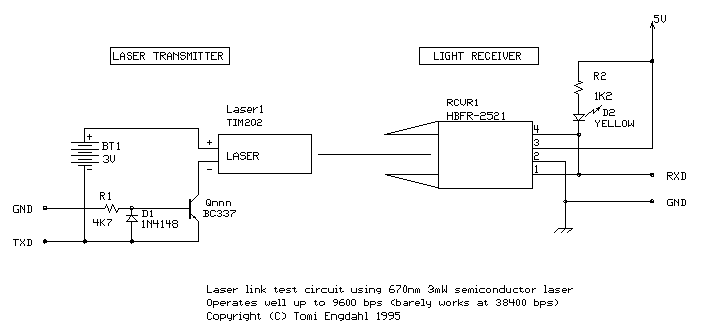Experimental Laser Data Link
Copyright 1996,1997 Tomi Engdahl

Summary of circuit features
- Brief description of operation: Wireless laser link for RS-232 port
- Circuit protection: No special protection circuits used
- Circuit complexity: Quite simple circuits
- Circuit performance: Seemed to work up to speeds of 9600 bps at distances of few meters. Circuit output does not fully meet the RS-232 specs but seems to work on typical PC RS-232 ports if short cables are used.
- Availability of components: Original components might be hard to get. Laser modules are now quite widely available but the suitability of other modules for this application is not known (some laser modules might performace poorly).
- Design testing: Simple short experimenting over distances of few meters. Long term reliabity of this circuit is not tested.
- Applications: Esperimental wireless communications using laser, connects to standard PC serial port, can be used with almost any communication program which uses any RS-232 speed this circuit can handle (max 9600 bps) and does not need then handshaking lines
- Power supply: 2 x 1.5V AA batteries (70 mA current), external +5V source (20 mA current)
- Estimated component cost: this circuit $80 ($160 for two needed for real bidirectional communication link)
- Safety considerations: Circuit uses laser radioation which can harm your eyes if you look directly to the laser beam. No special electrical safety considerations.
Circuit description
This document tells about one of my experiments with semiconductor laser modules. I bought one semiconductor laser for all kinds of experiments. This TIM202 module is a small (38x14x14 mm) semiconductor laser module, similar to those types used in laser pointers. It takes 3V 45mA and outputs 3-5mW 670nm laser beam.
One evening I got an idea to make a simple laser data link using this semiconductor laser module and some kind of receiver. Laser module can be easily modulated by switching it on and off using one transistor. I thought that receiving can be done easily with a one simple phototransistor circuit. I tested one simple circuit, but it did not work satisfactory. Then I got an idea to use ready-made receiving modules. I took out one HBFR-2521 fiber optic receiver module from my junk box. I checked the data of that module and found it to meet my needs: module is designed for 1 mm plastic fiber cable, module is designed for 665nm wavelenght and it can operate up to 5 mbit/s.
I started to test the system using computer. I connected the circuit to the RS-232C serial-port if my PC and placed the receiver and transmitter few meters away from each other. I started a communications program and tried the circuit with different communication speeds.

The test seemed to give quite nice figures. It first it seemed that all speed up to 115200 bps (maximum speed of standard PC serial port). But when I tested more, I found out that some characters just couldn't get through the link. I used lower speeds, but still there were some problems. I tested the link with my own test program and found out that communication at speeds over 9600 bps was unrealiable. As a result of this simple test I had created one direction 9600 bps laser link.
The reason why my system did not go must be in the laser module I was using, because the receiving module is capable for 5 mbit/s communication speeds. It is not fast enough to follow fast signals just by switching the power on and off. I never tested the signal with oscilloscope to see if laser module was slow in starting or stopping. To make sure that the slow component was laser, I tested the circuit also with original LED transmitetter and there were no speed problems either in hardare or software. The software I used were my own RS-232 speed tester program and Telemate terminal program both running running under MS-DOS.
I have later found out that most laser modules have capacitors to filter power supply noise and switch glitches. These capacitors limit the switching speed of the laser module, but they are necessary to preserve the laser diode which can be easily damaged.
Other possible circuits for receiving
Before trying the HBFR-2521 fiberoptical receiverr module I tried to use Simple infra-red detector as the detector /that circuit was also sensitive to visible light). That circuit did not give any useful results because it was too slow. I thought that using simple this type prototransistor circuit were not usable in this application.
Uday Kamath repoerted me that
he got good results up to 9600 bps using the following receiving circuit:
+5v
|
| collector
| /
---> |/ phototransistor
light |
---> |\
| V emitter
|_________________________ 0 and +5 out
|
/
\ 1.5k
/
\
|
gnd
The circuit it gives out 0 and 5 volts which is not compatible
with RS232. The circuit must be followed with
MC1488 (or some other) rs232 driver to convert this to RS232.
I have not tried this circuit, but the idea seems to be worth to try.
Notes on using lasers in this way
Modern laser diodes have lifetimes measured in 100,000 hours. Drive circuitry really is critical - overshoots that won't even show up on your scope may kill the laser diode. If the designers of your module may not have taken everything into account the laser diode life can be radically shortened when used in this type of circuit.
Other similar projects
You can find another RS-232 Laser Transciever project which is published in Electronics Australia Oct. 1997 at http://www.geocities.com/SiliconValley/Lakes/7156/laser.htm
Ideas for getting faster speeds
It seems that the reason for slow operation in mu laser link has been caused by (intentionally) slow operation of the laser diode module. Faster modulation speeds can be achieved when using a laser module which is designed to be modulated. There are some semiconductor laser modules which have modulation option built into the laser module (separate wire for modulation signal). Those laser modules are much more expensive than those cheap laser pointer laser modules.
For those interrested in faster laser link shoud take a look at the laser tranceiver project described at http://www.alphalink.com.au/~derekw/upntcvr.htm.
Tomi Engdahl <[email protected]>










